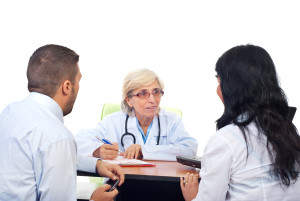By Iris Farrou
30 Dec, 2020
Pregnancy
Best gyns in Buffalo, Best OB practices in Buffalo, Best OBGYN Groups in Buffalo, Buffalo OBGYN, Chouchani MD, Healthy pregnancy, WNY OB-GYN, WNY Ob-gyn doctors, WNY OBGYN, women's health
 There comes a time at every pregnancy when the delivery of the baby becomes the issue at hand; many mothers have a choice on whether to go through a natural birth—also referred to as vaginal birth—or request a Caesarian section, most commonly known as C-section. Sometimes a C-section is necessary, especially in cases of medical concerns for the health of the baby or the mother, but when faced with the option it is a wise idea to be informed of the differences between the two methods of delivery, as well as their respective risks and complications.
There comes a time at every pregnancy when the delivery of the baby becomes the issue at hand; many mothers have a choice on whether to go through a natural birth—also referred to as vaginal birth—or request a Caesarian section, most commonly known as C-section. Sometimes a C-section is necessary, especially in cases of medical concerns for the health of the baby or the mother, but when faced with the option it is a wise idea to be informed of the differences between the two methods of delivery, as well as their respective risks and complications.
Overview
C-sections are a surgical procedure to deliver the newborn, and it takes place either when requested by the mother in lieu of natural birth, or when medical conditions make it necessary. Sometimes a C-section is pre-planned, while other times it may become necessary during labor. They are not as common as natural births, but the following conditions may make a C-section necessary for the safety of both the mother and the baby:
- General health medical concerns for the newborn
- Delivery of more than one baby
- Maternal infections or conditions, such as diabetes
- Problems with the placenta
- Delivery of a larger baby
- A labor that is not progressing in a timely manner, making it unsafe to continue naturally
A natural birth is a vaginal delivery, and it may take place with or without medical assistance for the pain. Natural births usually require a shorter hospital stay and have a faster recovery period. If the mother chooses to have a medical intervention to assist with a natural birth, this may be one of the following:
- Using Pitocin to induce labor
- An incision to help with the delivery of the baby without tearing the skin
- Artificially breaking the water, which would mean a rupture of the amniotic membrane
- A vacuum extraction
Procedure and Healing
Caesarean Delivery
In the case of a Caesarean section, the surgical procedure in general takes about 45 minutes. An incision is made through your abdomen and uterus to remove the baby, usually in the lower part of your uterus. As it is an operation, mothers may be given general anesthesia or an epidural block, where you will be awake during the procedure but not feel the lower part of your body.
The doctor cuts the umbilical cord, removes the placenta and closes the incision while the nurses may need to check the baby and clear their airway before they return it to the mother. Unlike natural birth, it may be a few minutes before the mother is united with her baby after a C-section.
As it is a surgery, recovering from a C-section will be similar to that of any kind of operation. There is a two to four day required stay at the hospital, and pain is to be expected when moving around or getting in and out of bed. The scar from the procedure may be itchy or painful in the first few weeks, like with any surgical scar, and cramps or discharge for about four to six weeks are natural.
Vaginal Delivery
A vaginal delivery happens in the hospital or a birthing center, and sometimes at home. In some cases, mothers opt for an epidural to numb the pain. There are three stages to this procedure: early, active, and transitional. Periodically, your cervix will be measured to determine whether you are fully dilated.
A full dilation is when the cervix is at 10 cm, when it is time to push. As the baby moves down the birth canal, the medical team assists with the delivery and uniting the newborn with the mother immediately. While the baby may be out, more contractions to extract the placenta are expected. Unlike a C-section, natural delivery has no specific timeframe and may take hours.
Takeaway
When the time comes to consider the safest option for you and your baby, always consult with your medical professional or your doctor. The safest choice depends on your medical history.
More

Though the word “mammogram” may ring as scary for many women, it is essentially an X-ray imaging of your breasts to detect a tumor or other abnormalities. There is no suggested or ideal age at which medical professionals agree one should start getting a screening mammogram, but typically women get their first mammogram between ages 35 and 40. Depending on risk level and preferences, women should discuss the options and risks with their doctor.
Remember that getting a screening mammogram does not necessarily mean there is cancer present: even if you get a call back, which is most common in first mammograms, it is most likely to look at a certain area more carefully. An extra ultrasound may be more commonly required in women who are pre-menopausal and get a mammogram done.
Facility Tips
- Choose a facility that specializes in mammograms and conducts a number of them in a day, speaking to its credibility and expertise. To reassure yourself about the standards being met, you may request to see an FDA certificate. If possible, visit the same facility every year so that your record is kept and comparisons may be done easily.
- Get your records from any other facility you may have visited in the past, so the pictures can be compared, and you can save some time.
- Also bring with you a list of places and dates when other mammograms may have been done, as well as biopsies or other breast treatments.
Day of the Mammogram
- Avoid deodorant, cream, or powder under your arms on the day you are scheduled to have a mammogram as those substances may show up as white spots.
- Wear clothes that will make it easy to remove just the top and your bra on the day of the exam.
- Try to schedule the mammogram on a day when your breasts are not swollen, so as to get a better picture and be more comfortable.
The Exam
- Most technologists are women, and you and the technologist should be the ones in the room during the exam. They will position your breasts accordingly for the mammogram.
- Expect your breasts to be compressed between two plates, and the procedure should take about 10-20 minutes, while the breast compression will not be more than a few seconds.
- For a screening mammogram, two views of each breast are required. For women with larger breasts or breast implants, more photos may be necessary.
- There may be some discomfort or pain during the procedure, but you should alert the technologist so they can try and make it more comfortable for you.
Though getting a mammogram does not necessarily mean you have a malignant lump or cancer, you should check with the facility if you don’t hear back from them—until you are certain, you should not assume the mammogram is normal. The best quality of a mammogram is that it can detect breast cancer even if it is too small to be felt; this means that it is diagnosed at a very early stage giving it the best chances at a successful treatment.
More

Pregnant women have unique health needs, as the foods they eat are the main source of nutrients for a growing baby. To cultivate healthy eating during pregnancy, it is important for pregnant women to plan in terms of vitamins and minerals and include foods that meet their unique nutritional needs, while limiting or avoiding certain processed foods, meats, and cheeses.
Foods to avoid:
For starters, pregnant women should avoid: refrigerated meat spreads; unpasteurized juices or milk; store-made salads (chicken, egg, tuna); unpasteurized soft cheeses (brie, feta, blue); raw sprouts; raw fish or refrigerated uncooked seafood (sushi, nova-style, lox, kippered, smoked, jerky); processed meats (hot dogs, deli meats); and certain cooked fish (shark, swordfish, king mackerel).
While fish and shellfish provide many important nutrients, such as iron and omega-3 fatty acids, pregnant women should be careful about both the type and frequency of seafood ingestion. The U.S. Department of Health and Human Services Office of Women’s Health recommends the following guidelines:
- Avoid fish high in mercury, such as swordfish, tilefish, king mackerel, and shark
- Eat up to six ounces per week of canned albacore or chunk white tuna
- Eat up to 12 ounces per week of cooked fish and shellfish including shrimp, crab, clams, oysters, scallops, canned light tuna, salmon, pollock, catfish, cod, and tilapia
Healthy foods to eat:
During pregnancy, women need increased levels of folic acid, iron, calcium, vitamin A, vitamin D, and vitamin B12. Specifically, pregnant women need 400 to 800 micrograms (mcg) of folic acid, 27 mg of iron, 1,000 mg of calcium, 770 mcg of vitamin A, 600 international unit (IU) and 2.6 mcg of vitamin B12. While taking supplements may help to reach these nutrient levels, it is preferable to consume vitamins and minerals through foods as certain supplements can contain higher than recommended levels of nutrients, which can be harmful to pregnant women.
To achieve healthy eating during pregnancy, see the list below of suggested foods per nutrient type especially important for pregnant women. This is not an exhaustive list but rather a starting point to help women plan a healthy diet for themselves and their babies.
Folic Acid/Folate
- Whole grains
- Avocados
- Eggs
- Beets
- Asparagus
- Leafy greens
- Legumes (lentils, peas, beans, chickpeas, soybeans, peanuts)
- Citrus fruits
- Brussels sprouts
- Broccoli
- Nuts and seeds
- Bananas
Iron
- Seafood (see specific seafood guidelines for pregnancy above)
- Legumes
- Broccoli
- Dark, leafy greens
- Lean meat
- Quinoa
- Nuts and seeds
- Tofu
- Dark chocolate
Calcium
- Dairy products
- Broccoli
- Dark, leafy greens
- Collard greens
- Soy beans
- Bok choy
- Oranges
- Seafood
- Legumes
Vitamin A
- Sweet potatoes
- Broccoli
- Dark, leafy greens
- Carrots
- Black-eyed peas
- Red bell pepper
- Mango
- Melon
- Apricots
- Tomatoes
- Pumpkin seeds
- Berries
Vitamin D
- Dairy products
- Fish liver oil
- Salmon
- Tuna
*Note: Vitamin D is the hardest nutrient to get solely from foods. A vitamin D supplement is recommended.
Vitamin B12
- Beef
- Chicken
- Seafood
- Dairy products
- Fortified breakfast cereal
- Eggs
More

With summer here, it’s time to understand the benefits of sunscreen. The reason for sunscreen is that the sun emits two harmful types of ultraviolet (UV) rays: UVA and UBA, which both lead to increased risk of skin cancer. Exposure to UVA rays has also been known to cause wrinkles. Research from the Environmental Protection Agency has established that up to 90% of skin changes from aging is actually caused by your skin’s exposure to UVA rays throughout your lifetime. Thus, limiting exposure by using sunscreen will help prevent signs of aging.
Dermatologists recommend a sun protection factor (SPF) of 15 or higher. Anyone with fair skin or a history of skin cancer should opt for SPF 30 or higher. While choosing a product with a high SPF is a good start, it’s important to understand that SPF only protects against UVB rays. In order to find coverage against UVB and UVA, look for products that are called “broad-spectrum sunscreens,” as these products include additional protection from UVA. There is no rating system to assess how well a sunscreen will block UVA rays, so reading the list of ingredients is key. To project against UVA rays, choose a product with any of the following ingredients: ecamsule, avobenzone, oxybenzone, titanium dioxide, sulisobenzone, or zinc oxide.
Another important consideration is the impact the sunscreen’s ingredients have on the environment, especially if swimming in the ocean due to fragile coral reefs. Some beaches in Hawaii and Florida ban sunscreens that contain certain chemicals such as octocrylene, oxybenzone, and octinoxate. When looking for eco-friendly options consider buying a mineral-based sunscreen with “non-nanotized” zinc oxide or titanium dioxide. While mineral-based products are not as effective at blocking UV rays, they still can offer decent coverage. A good compromise for maximum protection and environmental awareness would be to select an oxybenzone-free chemical sunscreen. Oxybenzone is a chemical known for environmental damage.
Once you have selected a broad-spectrum sunscreen with an SPF of 15+, be sure to apply it 15 to 30 minutes before sun exposure. Typically, one ounce (roughly two tablespoons) will be enough to cover the body. It’s important to apply an even and consistent layer. Regardless of how long the sunscreen is supposed to last, it’s best to reapply every two hours (more if you are exercising or swimming). Be sure to wear sunscreen on cloudy days, as well as sunny ones, as clouds do not stop UV rays. Pay attention to expiration dates, as sunscreen loses effectiveness over time. While sunscreen is a good first defense, no sunscreen can fully protect 100% against UV rays. In addition to wearing sunscreen: opt for shade when possible, wear hats and sunglasses, and aim to void the sun’s most intense hours from 10 a.m. to 4 p.m.
More
 Summer is the perfect time of year for all our favorite warm-weather activities; from drinking cool glasses of sweet lemonade, to swinging in hammocks under the shade, to getting out and being active. What better way to enjoy a low-impact summer-time activity that requires a minimal investment in equipment and supplies, than by bike riding. Summertime bike riding is the perfect way to enjoy warm summer days and get fit. Don’t take this easy-breezy activity for granted, though. Bike riding is not without its safety hazards. Before you pedal the pavement, read our summer bike safety tips (and yes, that includes wearing a helmet!).
Summer is the perfect time of year for all our favorite warm-weather activities; from drinking cool glasses of sweet lemonade, to swinging in hammocks under the shade, to getting out and being active. What better way to enjoy a low-impact summer-time activity that requires a minimal investment in equipment and supplies, than by bike riding. Summertime bike riding is the perfect way to enjoy warm summer days and get fit. Don’t take this easy-breezy activity for granted, though. Bike riding is not without its safety hazards. Before you pedal the pavement, read our summer bike safety tips (and yes, that includes wearing a helmet!).
- Protect Your Head. Even though the law only requires children under the age of 14 to wear safety certified bicycle helmets in New York, adults should wear them too. According to data provided by the U.S. Department of Transportation, each year approximately two percent of motor vehicle crash deaths are bicyclists, and in a majority of bicyclist deaths, the most serious injuries are to the head. In addition, helmet use has been estimated to reduce the odds of head injury by 50 percent, and the odds of head, face, or neck injury by 33 percent.
- Be Alert. Whether you’re biking on a busy road with two-way traffic, or on a quiet neighborhood side street, always be alert for pedestrians, other bikers, pets, vehicles, and unexpected road hazards. Learn to always scan ahead, center, left, and right. Resist the temptation to look down at the ground. Keep your head up to scan the upcoming area for obstacles or hazards.
- Be Seen. Especially if you’ll be biking on main roads, utilize proper and expected hand signals:
- Right Turn: Extend your right arm out straight with all fingers extended or use your index finger to point right.
- Left Turn: Extend your left or right arm sideways and bend your arm at a 90-degree angle at the elbow, hand pointing down, and the palm of your hand facing backwards.
- Also, make sure your bike is equipped with a horn, and a reflector and light for evening travel.
- Travel Safely in Pairs and Groups. Biking can be a great group activity, but make sure to do it safely. Whenever biking with another person, or with a group, ride in a single file line with enough space between bikers that if one has to stop abruptly, you won’t be at risk of a collision.
- Ride on the Right Side of the Road. Unlike pedestrians, bikers are required by law to ride with traffic. Not against it. Bike on the right side of the road. Failure to follow traffic rules could result in a law enforcement ticket.
- Have Fun. Getting out and being active is one of the best ways to maximize the summer sun before we all have to trade in our lemonade and sandals for pumpkin spice lattes and fur-lined boots. Enjoy what’s left of the summer by biking your way to fitness. Just remember to put your safety first in every situation.
More
 It’s easy to remember that smoking can put you at risk for cancer, but it can be easy to forget that the summer sun we love so much can be just as dangerous. According to the Skin Cancer Foundation, each year in the United States over 5.4 million cases of non-melanoma skin cancer are treated in more than 3.3 million people. Every year, there are more new cases of skin cancer than the combined incidences of breast, prostate, lung, and colon cancer, and over the past 30 years, more people have had skin cancer than all other cancers combined.
It’s easy to remember that smoking can put you at risk for cancer, but it can be easy to forget that the summer sun we love so much can be just as dangerous. According to the Skin Cancer Foundation, each year in the United States over 5.4 million cases of non-melanoma skin cancer are treated in more than 3.3 million people. Every year, there are more new cases of skin cancer than the combined incidences of breast, prostate, lung, and colon cancer, and over the past 30 years, more people have had skin cancer than all other cancers combined.
You don’t have to stay indoors all summer long to protect yourself from skin cancer, but you do need to understand the risks and make choices that will limit your direct sun exposure. Read on for our summer sun safety best practices, and tips for choosing the SPF that’s right for you.
Tips to Limit Your Sun Exposure
- Stay in the shade, especially between 10 a.m. and 4 p.m., and during late spring and early summer when UV rays are the strongest.
- Do not intentionally tan.
- Avoid sunburns. Getting sunburned just once every two years can triple your risk of developing melanoma skin cancer.
- Wear a broad-brimmed hat and sunglasses with UV-coating to protect your face and eyes.
- Wear long sleeves and pants of breathable fabric while out in the sun.
- Use extra caution around water, snow, and sand, as such surfaces reflect damaging rays, which can increase your chance of a sunburn.
- Protect yourself, even on cloudy or hazy days, as 80% of damaging UV rays can still reach you through the clouds.
- Wear sleeves or sunscreen even when driving. Harmful UVA rays can still reach you through window glass.
Sunscreen and SPF Facts
- Sunscreens are regulated as over-the-counter drugs by the U.S. Food and Drug Administration.
- SPF stands for sun protection factor. Sunscreens with a higher SPF generally offer more protection from the sun’s UV radiation.
- The SPF rating on a sunscreen product refers mainly to the level of UVB protection it offers. For example, SPF 15 blocks 93% of UVB radiation, while SPF 30 blocks nearly 97%. Higher sunscreens block slightly more UV rays, but no sunscreen can offer 100% protection.
- SPF clothing is 100% effective at blocking UV rays, making it more effective than regular cotton materials.
- The FDA has banned sunscreens from claiming to be waterproof or sweat proof, however there are products available that offer protection if you plan to be in the water. Water resistant products are generally effective for up to 40 minutes in water, while very water resistant products are generally effective for up to 80 minutes in the water.
SPF Recommendations
- When outdoors, always apply a broad spectrum (UVA/UVB) sunscreen of SPF 30 or higher. Such sunscreens protect you from both types of damaging UV rays.
- When choosing sunscreens, read the label. If a product has a skin cancer/skin aging alert in the Drug Facts section, it means it will only prevent sunburn and will NOT reduce the risk of skin cancer.
- Always choose a sunscreen that is water resistant, but especially if you anticipate extended outdoor activity.
- Apply one ounce of sunscreen (enough to fill a shot glass) to your entire body, and to dry skin, 15 to 30 minutes before going outside.
- Reapply sunscreen every two hours or immediately after swimming or excessive sweating.
- Don’t forget to protect your lips. Choose a lip balm that contains at least SPF 30.
- Rather than using a product that claims to offer SPF and insect repellent, use these products separately for best results.
- Check the date of your sunscreen. The FDA requires that sunscreens retain their strength for at least three years. If you have an old bottle at home, or one that has passed its expiration date, replace it.
- Sunscreens come in a variety of forms. Choose the one that best fits your needs:
- Creams – Best for the face and dry skin.
- Sprays – Often chosen by parents for their convenient application, just be sure to apply the proper amount.
- Gels – Best for hairy areas.
- Sticks – Best for application around the eyes.
If you have any questions or concerns regarding summer sun exposure, or your personal risk factors for skin cancer, talk to your doctor. Chouchani, Sayegh and Robinson MD are currently accepting new patients. Call for an appointment today.
More
 Infertility. Go ahead and say the word out loud. There is no reason to feel embarrassed or ashamed if you fear you may be experiencing infertility issues. Rather than fearing that infertility is a word that should go unspoken and unacknowledged, learn the truth about this treatable condition, and when you should seek help.
Infertility. Go ahead and say the word out loud. There is no reason to feel embarrassed or ashamed if you fear you may be experiencing infertility issues. Rather than fearing that infertility is a word that should go unspoken and unacknowledged, learn the truth about this treatable condition, and when you should seek help.
Infertility Defined
Infertility is a condition of the reproductive system. Not entirely a female-related condition, approximately 30 percent of infertility is due to a female factor, 30 percent is due to a male factor, and the remaining 40 percent is due to problems in both partners or some other unexplainable component.
Infertility-Related Definitions
What follows is a list of some common terms associated with infertility that you should familiarize yourself with if you feel you may be experiencing this condition.
ART (Assisted Reproductive Technology) – Any procedure where a woman’s eggs are surgically removed from a woman’s ovaries and combined with sperm to assist a woman in getting pregnant. IVF, GIFT, and ZIFT are all forms of ART.
Cryopreservation – The process of freezing extra embryos from a couple’s ART procedure for potential future use.
DES Exposure – A possible cause of infertility, Diethylstilbestrol (DES) is a synthetic form of estrogen that was prescribed to pregnant women between 1940 and 1971 to prevent pregnancy complications. It is now known that DES may be the cause of premature birth, miscarriage, and ectopic pregnancy among daughters born to mothers who were prescribed DES before it was banned by the Food and Drug Administration (FDA).
Endometriosis – A possible cause of infertility, endometriosis is a painful chronic condition in which tissue, like that which lines the uterus, develops outside the uterus in areas such as the abdomen, on the ovaries, fallopian tubes, and ligaments that support the uterus.
Follicle-Stimulating Hormone (FSH) – A hormone produced by the pituitary gland that helps an egg mature and be released. High levels of FSH may be an indication of infertility caused by low ovarian reserves.
Gamete Intrafallopian Transfer (GIFT) – A procedure to treat infertility in which a woman’s eggs are removed, mixed with sperm, and immediately placed into her fallopian tube.
In Vitro Fertilization (IVF) – A procedure to treat infertility in which a woman is prescribed an ovulation stimulating medication to produce an excess number of eggs. The eggs are surgically removed and fertilized in a dish with sperm. If fertilization is successful, the embryo is transferred back to the woman’s uterus.
Intracytoplasmic Sperm Injection (ICSI) – A procedure used to treat infertility in which a single sperm is injected directly into an egg.
Intrauterine Insemination (IUI) – Formerly known as artificial insemination, IUI is a procedure used to treat infertility. The procedure takes the male’s sperm, washes and treats it, then injects it into the woman during ovulation to increase the chances of conception.
Luteal Phase Defect (LPD) – A possible cause of infertility, LPD occurs when the ovaries don’t release enough progesterone, or the uterine lining does not adequately respond to the hormone.
Male Factor Infertility (MFI) – A term used when a man has a lower than normal chance of fertilizing an egg without assistance.
Miscarriage – Also referred to as “spontaneous abortion,” a miscarriage is the spontaneous loss of a fetus before the twentieth week of pregnancy.
Reproductive Endocrinologist – A specialist who identifies and treats infertility in both men and women.
Tubal Disease – A possible cause of infertility, tubal disease is a disorder in which a woman’s fallopian tubes are blocked or damaged, restricting the egg and subsequent embryo from making it to the uterus.
Uterine Factor – A structural or functional disorder of the uterus that results in reduced fertility.
Zygote Intrafallopian Transfer (ZIFT) – A procedure used to treat infertility in which a woman’s eggs are surgically removed and fertilized in a dish with sperm. If fertilization is successful, the embryo is transferred back to the woman’s fallopian tube.
When Should You Seek Help?
You may be diagnosed with infertility if you are under age 35 and have had unprotected, well-time intercourse for one year without being able to get pregnant and/or carry a baby to term. You may also be diagnosed with infertility if you are age 35 or older and have had unprotected, well-timed intercourse for six months without being able to get pregnant.
If either of these scenarios describes you, and you think you may be experiencing infertility, speak with your OB-GYN. He/she can properly diagnose you and help guide you toward a treatment plan that is right for you and your family. And if you are looking for a new practice and live in the WNY area, give our team a call today. We are accepting new patients.
More
 Postpartum depression is a devastating emotional disorder that negatively impacts a significant number of mothers every year. It’s estimated that approximately 10 to 15 percent of women suffer from some form of postpartum mood disorder (PPMD), including postpartum depression (PPD), postpartum anxiety/OCD, or postpartum psychosis. If you feel that you or a loved one could be suffering from this emotionally, and physically painful disorder, know that you are not alone, and that treatment is available to help you recover and begin enjoying your time with your new baby in positive ways.
Postpartum depression is a devastating emotional disorder that negatively impacts a significant number of mothers every year. It’s estimated that approximately 10 to 15 percent of women suffer from some form of postpartum mood disorder (PPMD), including postpartum depression (PPD), postpartum anxiety/OCD, or postpartum psychosis. If you feel that you or a loved one could be suffering from this emotionally, and physically painful disorder, know that you are not alone, and that treatment is available to help you recover and begin enjoying your time with your new baby in positive ways.
Symptoms of Postpartum Depression
Postpartum depression symptoms typically develop within the first few weeks after baby is born, but could begin up to six months after birth. While every case is different, typical symptoms of postpartum depression may include:
- Feelings of anxiety or sadness that result in pulling away from family and loved ones.
- Panic attacks.
- Unexplainable sadness that leads to seemingly unprovoked, excessive crying.
- Rapid and severe mood swings.
- Unexplainable feelings of sadness or depression.
- Uncontrollable and intense irritability and/or anger.
- Overwhelming fatigue.
- Difficulty sleeping, or wanting to keep all the time.
- The feeling of being overwhelmed, and/or unable to concentrate, think clearly, or make decisions.
- Not feeling hungry as usual, or overeating.
- Reduced interest in hobbies or typically enjoyable activities.
- Having difficulties bonding with your baby, and/or a strong fear that you are not a good mother.
- Irrational thoughts of harming yourself, or your baby.
- Thoughts of suicide or death.
Your Doctor Can Help
If left untreated, postpartum depression may last for many, painful, and sad months where you are not bonding with your baby in the ways that you’d like. In the most severe cases, postpartum depression can have devastating, deadly consequences.
If you or a loved one think you may be suffering from postpartum depression, your OGBYN can help. A variety of treatment options are available. Your doctor will customize a treatment plan that is right for you, based on your unique circumstances or symptoms. Your recovery plan may include any of the following treatments:
- Medication — Postpartum depression is caused by severe fluctuations in hormones. To treat these changes and restore balance to your system, your doctor may prescribe an antidepressant. Medication can also be helpful in improving your sleep- and appetite-related symptoms.
- Psychotherapy (talk therapy) — For many women suffering from postpartum depression, talk therapy has proven successful either as a stand alone treatment, or when used in conjunction with antidepressant medication. Psychotherapy helps women suffering from postpartum depression to work through their feelings and resolve internal emotional conflicts with the support of a trained professional.
- Support groups — Similar to individualized psychotherapy, support groups can be an effective way for women to feel the support of others with whom they share similar feelings and experiences. Support groups may be recommended in conjunction with medication.
- Inpatient treatment — In the most severe cases, such as when a woman’s postpartum depression is presenting as suicidal ideation, your doctor may recommend a more intense treatment program provided in a focused, inpatient setting. When your doctor is confident that you are not a danger to yourself, or your baby, you will be discharged for continued outpatient treatment.
The initial months after your baby is born are essential for proper emotional bonding, and developing the skills you will need to care for your baby long term. Don’t let postpartum depression interfere with those precious months. Talk to your OBGYN today and learn what your options are, not just for managing symptoms, but for treating the underlying condition that is impacting your emotional and physical well-being.
The doctors at Chouchani, Sayegh and Bagnarello take your physical and mental health very seriously. If you have been experiencing any of the symptoms mentioned above post pregnancy, please schedule an appointment to talk with us.
More
 If you’ve ever experienced the searing, burning, indescribable pain that is a urinary tract infection (UTI), then you certainly never want to experience one again. If you are among the lucky ones that have never experienced this painful health condition, count yourself among the fortunate. Regardless if you have experienced a UTI in the past or not, there are several steps that all women can take to stay healthy, and mitigate their risk of experiencing this unpleasant condition.
If you’ve ever experienced the searing, burning, indescribable pain that is a urinary tract infection (UTI), then you certainly never want to experience one again. If you are among the lucky ones that have never experienced this painful health condition, count yourself among the fortunate. Regardless if you have experienced a UTI in the past or not, there are several steps that all women can take to stay healthy, and mitigate their risk of experiencing this unpleasant condition.
- Stay hydrated. Women should drink plenty of water throughout the day for a variety of health reasons, but staying hydrated can also be an effective prevention technique for preventing UTIs. Water helps to dilute your urine, and encourages you to urinate more frequently—two factors that help ensure that the bacteria that can cause a UTI is regularly flushed from your urinary tract. When you urinate, your urine should be a very pale yellow if you are drinking enough water.
- Hydrate after sex too. Also, be sure to drink a full glass of water after sex, and immediately empty your bladder after intercourse. These two practices will again help to flush unwanted bacteria out of your urinary tract.
- Wipe front to back. After a bowel movement, be sure to wipe from the front to the back, and never wipe twice with the same tissue. Following proper cleansing techniques can prevent pathogenic bacteria that originates in the anal region from spreading to your vagina and urethra, where it can cause a UTI.
- Carefully choose feminine products. Irritating feminine hygiene products, such as certain douches, powders, and deodorant sprays, can irritate your urethra, and lead to infection.
- Choose tampons over sanitary napkins. Unlike sanitary napkins or pads, tampons keep the bladder opening area drier, which limits the possibility of bacterial growth.
- Urinate frequently. Avoid long periods of time in between urinating. Aim to empty your bladder completely at least once every four hours during the day to mitigate the risk of bacterial build-up.
- Consider changing your birth control. If you use diaphragms, or unlubricated or spermicide-treated condoms, these forms of birth control can put you at risk of bacterial growth that can cause a UTI.
- Wear loose clothing. Tight-fitting undergarments and non-breathable materials can encourage moisture build-up, which can lead to maceration of the skin and bacterial overgrowth. Choose breathable underwear to prevent contamination of the bladder opening area.
- Choose showers over baths. Avoid soaking in bathwater for prolonged periods of time. Bath water can become contaminated with skin florae as you bathe, and allow bacteria to reach the bladder opening area.
If you have any questions or concerns about your risk for developing a UTI, speak with your OBGYN. If you feel you may be experiencing UTI symptoms, be sure to contact your docotor immediately so that he or she can prescribe treatment and set you on the road to recovery.
More
 You have been waiting for nine months to meet your new baby. With each day that passes, your anticipation grows until you are wishing every minute of every day for the time to come. When the moment finally does arrive you’ll know, won’t you? You may be surprised to know that there are several signs and symptoms that you should watch for to determine when you have truly gone into labor. Familiarize yourself with the list of labor signs below so that you will be ready to go for the ultimate go time.
You have been waiting for nine months to meet your new baby. With each day that passes, your anticipation grows until you are wishing every minute of every day for the time to come. When the moment finally does arrive you’ll know, won’t you? You may be surprised to know that there are several signs and symptoms that you should watch for to determine when you have truly gone into labor. Familiarize yourself with the list of labor signs below so that you will be ready to go for the ultimate go time.
Contractions That Occur at Regular Intervals. One of the most accurate ways to tell if you are in labor is to time the sensations you believe to be contractions. In the beginning, the contractions will feel like menstrual cramps. Begin to time the “contractions” from the start of one to the start of the next. If they occur at regular intervals, with about the same amount of time in between, and if they start to appear closer to one another or if the pain increases, you’re likely in labor.
You Lose Your Mucus Plug. The mucus plug prevents bacteria from entering the uterus by blocking the opening to the cervix. Before labor, however, the mucus plug is expelled, ultimately allowing the baby to pass through the cervix during birth.
Bloody Show. When the mucus plug is expelled, you may experience what is known as “bloody show,” which is a mucusy discharge tinged pink or brown by blood. The appearance of the bloody show is a sign that blood vessels in the cervix are rupturing as it begins to dilate.
Your Water Breaks. This is the sign that everyone anticipates as the ultimate signal of labor, but don’t count on it. Breaking water only occurs in less than 15 percent of births. If your water does break, you will experience a trickling or gushing of amniotic fluid. The liquid should be odorless. If you do notice a color, or an odor, call your OBYGN immediately, as it may be a sign that the baby is in distress and has passed meconium, or the earliest infant stool, in the uterus.
Loose Joints. During your pregnancy, your body produces the hormone relaxin, which makes all of your ligaments soften. Before labor, you may feel as if your joints have gone loose. This is your body’s natural way of preparing your pelvis for the birth.
Nesting. Some women experience a biological phenomenon known as nesting in the days and weeks before birth. Nesting during pregnancy is the overwhelming desire to get your home ready for your new baby. When nesting occurs women experience a burst of energy and find themselves motivated to clean, or bake, or in some way prepare the home for their new arrival. Just be careful not to overdo it!
The birth of your baby will be a monumental moment in your lives. Remember to stay calm, and if you have any concerns about the symptoms you are experiencing, contact your OBGYN. Your doctor is prepared to help you bring your newest member of your family into the world as safely as possible.
More
 There comes a time at every pregnancy when the delivery of the baby becomes the issue at hand; many mothers have a choice on whether to go through a natural birth—also referred to as vaginal birth—or request a Caesarian section, most commonly known as C-section. Sometimes a C-section is necessary, especially in cases of medical concerns for the health of the baby or the mother, but when faced with the option it is a wise idea to be informed of the differences between the two methods of delivery, as well as their respective risks and complications.
There comes a time at every pregnancy when the delivery of the baby becomes the issue at hand; many mothers have a choice on whether to go through a natural birth—also referred to as vaginal birth—or request a Caesarian section, most commonly known as C-section. Sometimes a C-section is necessary, especially in cases of medical concerns for the health of the baby or the mother, but when faced with the option it is a wise idea to be informed of the differences between the two methods of delivery, as well as their respective risks and complications.








